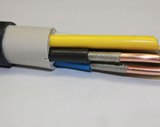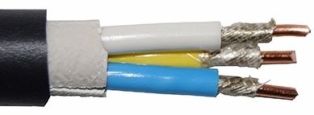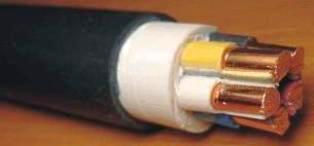Features and types of installation of the cable VVG-ng
 VVG-ng — copper flexible cable in PVC insulation, which does not support combustion. It has both a round and flat design, which is convenient for some types of installation. Today, VVG-ng cable is considered the most common cable product for wiring, both in residential and industrial premises.
VVG-ng — copper flexible cable in PVC insulation, which does not support combustion. It has both a round and flat design, which is convenient for some types of installation. Today, VVG-ng cable is considered the most common cable product for wiring, both in residential and industrial premises.
According to the technical characteristics, the cable of the VVG-ng brand has a different version of single-core and multi-core conductors, and according to GOST - the mass of the wire cross-sections. The VVG-ng cable is designed for operation at an alternating voltage of 660 V and higher, with a frequency of 50 Hz. The permissible temperature of the wire is + 70 ° C, and the working range is not limited for the territory of the Russian Federation. The permissible temperature when installing a VVG-ng cable is not lower than -10 ° C.
The bend during the installation of the wire should be 10 diameters for single-core cables and 7.5 diameters for multi-core cables. The life of the cable of this brand is more than 30 years.

VVGng-FRLS cable
Types of cable installation VVG-ng
1. By open method:
Based on the technical characteristics of the cable, it is allowed to lay it open on surfaces and structures made of non-combustible or hardly flammable materials such as plaster, concrete, bricks, plastered surface, etc. It is also possible to place the cable exposed on overhead structures such as cable etc. ensures reliable laying and does not allow mechanical impact on the cable such as sagging and stretching.
If there is a risk of mechanical damage to the cable, additional protection must be installed. Also, additional protection should be used when installing the cable in an exposed manner on combustible wooden surfaces, and the installation should be carried out using protection, such as cable duct, corrugated hose, metal hose, pipes, etc.
2. Laying the cable along the cable supporting structures:
Cable support structures include pipes, cable trays, boxes, etc. This installation method is more suitable for industrial premises than for residential ones. When laying a cable in production, the category of premises in which the cable and cable-bearing structures are installed, as well as environmental factors, must be taken into account.
On supporting cable structures it is allowed to lay VVG-ng cable in a bundle. The number of cables in the bundle is determined by the above factors and the technical characteristics of the structures, as well as by the rules for electrical installations.
3. Concealed VVG-ng cable laying:
Concealed is the most common method of cable installation in residential premises. The cable is laid in made channels, under plaster, in cavities, etc. This method has no possibility of mechanical damage, therefore it does not require additional protection.Exceptions to the emptiness of the walls of wooden houses, where hidden laying of cables in non-combustible materials, pipes, metal hoses, etc. is allowed. The correctness of the installation of the hidden laying of the VVG-ng cable is determined by the regulatory documents for hidden electrical cables.
4. Laying the cable in the ground:
The VVG-ng cable is not recommended for laying in the ground, as it has no natural protection against mechanical loads, but it is possible to lay such a cable in the ground using additional protection such as pipes, tunnels, HDPE pipes, etc. .
Each of the installation methods must be carried out in accordance with regulatory documents, technical characteristics of electrical equipment, rules for electrical installations (chapter 2.1 Wiring) with the participation of qualified personnel who are authorized for this type of work.

